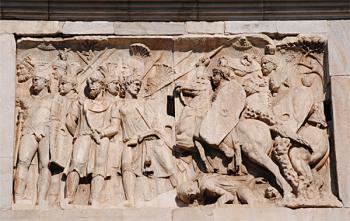American Journal of Archaeology | The Journal of the Archaeological Institute of America
You are here
Setting War in Stone: Architectural Depictions on the Column of Marcus Aurelius
April 2018 (122.2)
Setting War in Stone: Architectural Depictions on the Column of Marcus Aurelius
The depictions of architecture on the Column of Marcus Aurelius are an important means of exploring how war along the frontier was presented to the capital. A comprehensive comparison between Antonine architectural depictions and their models on the Column of Trajan demonstrates careful modifications on the part of the Antonine designers to adapt Trajanic models to particular Antonine goals. The architectural depictions of the Antonine column frieze reinforce the larger ideological themes of the monument as a whole, portraying victory not only as the suppression of a barbarian threat but also as independent of expansion of Roman territory, in a dramatic departure from Trajanic precedents. The depicted architecture also reveals that the Antonine frieze should not be read merely as a dialogue between itself and the Column of Trajan but instead as part of a larger conversation among monumental reliefs in Rome, including the Great Trajanic Frieze and the Marcus Aurelius panels. Although traditionally analyzed for information concerning realities of the frontier, the presentation of war on the Antonine column frieze can be better understood as a means of addressing the experiences and concerns of a particular audience—namely, residents in the capital.
Setting War in Stone: Architectural Depictions on the Column of Marcus Aurelius
By Elizabeth Wolfram Thill
American Journal of Archaeology Vol. 122, No. 2 (April 2018), pp. 277–308
DOI: 10.3764/aja.122.2.0277
© 2018 Archaeological Institute of America


